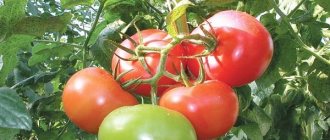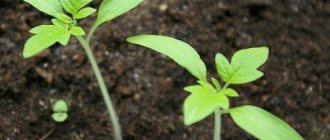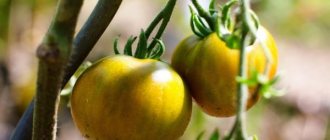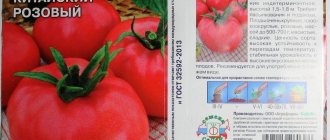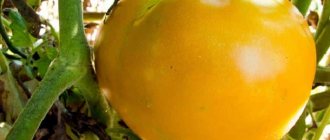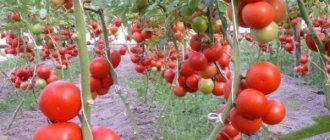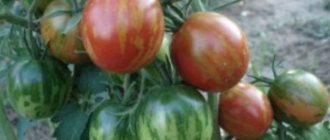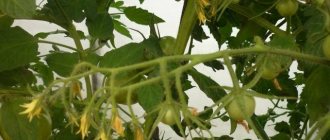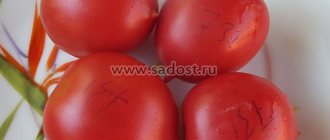Tomatoes called “Volgogradets” are very popular among summer residents. Tomatoes have a deep flavor. The fruits of this variety have a beautiful appearance and rich taste, so most amateur gardeners prefer this variety for planting. These plants are very productive. Volgogradets tomatoes have remained popular on the market for a long time.
Tomatoes "Volgogradets" can be planted in open ground. The bushes of these tomatoes are spreading and have abundant foliage. Tomatoes of this variety can reach a height of 75 cm. In addition, tomato bushes are compact, which greatly facilitates their processing and care. The leaves of the tomato are small and light green in color. The Volgogradets tomato is not a hybrid. Fruits can be grown both in greenhouse conditions and in open ground.
“Volgogradets” tomatoes have a number of positive qualities, so they are planted not only by summer residents on their plots, but also by farmers for mass production. Tested for more than one year of cultivation, tomatoes have proven themselves to be abundantly fruitful. They are very tasty and juicy. In addition, the fruits ripen at the same time, which significantly facilitates the work.
It won’t be a problem to find many reviews about this variety, most of which are positive. In the photo you can see “Volgogradets” in all its glory. It is worth noting the fact that tomatoes of this variety are not afraid of such common diseases as: fusarium, brown spot, verticillium.
Description and characteristics of the variety
Tomato Volgogradets is a determinate medium-growing variety. Strong bushes do not grow higher than 75 cm. Powerful shoots evenly form 5-7 fruiting clusters, foliage is significantly expressed.
Ripening is average - 115-125 days from planting. The average weight of tomatoes varies from 60 to 90 g.
The fruits are bright red and round in shape. The pulp is juicy, fleshy, tasty. Tomatoes are easily transported and retain their presentation for a long time. Sourness and sweetness are harmoniously balanced in taste.
Bush care
What care does tomato bushes need:
- Excessive watering should be avoided. In the absence of dry periods, watering is carried out once every two weeks. In case of prolonged drought, watering becomes more frequent, but without fanaticism. Otherwise, all the energy will go to the growth of green mass, which will negatively affect the number of fruits. The moisture level is quite easy to control: if the soil is moist at a depth of 10 cm, it does not need watering;
- If the number of ovaries is insufficient, the bushes are treated with urea or boric acid;
- It is recommended to feed the plantings with compost and rotted manure, which guarantees a bountiful harvest;
- One of the main advantages of the variety is the absence of the need for pinching. However, if this procedure is necessary, it is worth carrying out;
- It is advisable to carry out weeding at an early stage of growth, and loosening at a later stage. Don't forget about hilling. This activity is carried out several times until the plant begins to bear fruit;
- It is also necessary to carry out mandatory treatments using special means to prevent the possible occurrence of various diseases. In addition, with the help of timely treatment, the appearance of insect pests can be avoided.
Features of cultivation and storage
Seeds for seedlings are sown in the 1st-2nd decade of March. The soil is chosen to be fertile and loose, and compost, ash, peat, and sand are added. Treat with 1% potassium permanganate for disinfection. For improved germination, seeds are soaked in “Kornevin” or “Epin”.
Planting depth is 1.5-2 cm. Sprinkle mulch or fine soil mixture on top.
How to care for seedlings:
- irrigate with a spray bottle with warm, settled water;
- harden for a week;
- fed with “Strong”;
- dive into 0.5 liter pots.
Store ripe tomatoes for 3-4 weeks in a cool, dark place.
Growing tomatoes
The tomato variety “Volgogradets” can be cultivated using both seedling and non-seedling methods. Traditionally grown through seedlings.
How to prepare seeds:
- First, it is worth disinfecting the seed material by placing it in a weak solution of potassium permanganate for 15-20 minutes. Then the seeds are washed and dried;
- Before sowing, soaking in a growth stimulator is necessary.
Sowing seed material:
- Seeds are sown for seedlings in mid-February;
- The planted seeds are placed in a warm place until the first shoots appear;
- With the emergence of seedlings, you need to lower the temperature and place the containers on a windowsill with sufficient lighting;
- After the formation of the first pair of true leaves, the seedlings are picked.
Rules for planting seedlings:
- Tomato bushes are transplanted into unprotected soil in April, into a greenhouse structure - in March;
- To grow tomatoes, it is advisable to use sandy soil, after carrots, cabbage, legumes or eggplant;
- Pre-planting soil treatment is carried out with boiling water to disinfect it;
- Planting holes are placed at intervals of 60-70 cm, observing the recommended density - no more than 5-6 seedlings per 1 m2.
In what regions is it grown?
The Volgogradets tomato variety was first bred by Russian breeders at the beginning of the 21st century.
Currently, it is grown in open ground in the following regions:
- Central Black Earth;
- North Caucasian;
- Ural;
- Far Eastern.
Cultivation can be intended for both infrequent and one-time mechanized harvesting.
Agricultural technology
Growing seedlings
It is recommended to sow seedlings 60-70 days before planting in a permanent place. The month of March is ideal. Depending on the climate, the summer resident himself decides when to do this business: at the beginning, middle or end of the month. In central Russia (for example, in the Moscow region), seedlings begin to be planted on the 20th of March. Thus, by mid-May the bushes will already be stronger. Due to the fact that the variety is early, the seeds can be planted in open ground or a greenhouse at the end of May. But the seedling method is the most preferable. At home, seeds have almost 100% germination.
Soaking the seeds
The seeds are first soaked for several days in water or placed in damp gauze. Be sure to be treated with a manganese solution. The substrate for planting can be purchased at the store or formed independently. The main thing is that the soil mixture is free of pathogenic microbes and pests. To do this, it is fried in the oven and treated with boiling water. The variety grows better in soil where there is a sufficient amount of humus, sand and fly ash.
The substrate is placed in containers, wooden boxes. Ideally, the container will have drainage holes. This way you can avoid waterlogging of the soil.
Before planting, the soil is moistened. The seeds are planted to a depth of 1-2 cm. The distance between them is 2-4 cm. Next, the box is covered with a bag. In such an environment, the seeds will germinate better. Shoots can be seen in 5-7 days. After they appear, the package is deleted. The box is placed on the windowsill, towards the light.
Important! Representatives of the variety have a strong root system. Its peculiarity is that it grows both in the depth of the earth and in width
Therefore, Volgograd tomato seedlings need picking. Each bush is transplanted into a separate container as soon as it has 2 leaves.
Landing
The seedlings are transferred to a permanent location in May. It is best to prepare the bed in the fall. It is dug well and fertilized with organic matter. Holes are dug. They are placed at a distance of about 60-70 cm from each other. The variety's roots grow well in width. Because of this, it is recommended to plant bushes at some distance from each other. This way they will receive the necessary nutrition in sufficient quantity. Before planting the bushes, the holes are well watered. Add a glass of ash to each.
Care
Growing Volgograd tomato 323 involves simple care. The most necessary events:
- Watering;
- Application of fertilizers;
- Weeding;
- Loosening;
- Mulching;
- Prevention of diseases and pests.
Watering
The variety does not require watering. It is recommended to water the bushes no more than once every 14 days. It should be watered with warm water. You can pour the stream strictly under the plant, avoiding moisture getting on the foliage.
Fertilizer application
The procedure is carried out 2 times. The first time is 14-16 days after planting the seedlings in the garden. To do this, use a little nitrogen fertilizer. You can take urea. The second time, feeding takes place as soon as the gardener sees the first flowers. At this time, preparations containing phosphorus and potassium are taken. You can use bird droppings. It should be diluted with water in the following proportions: one part of litter to 15 parts of water.
Weeding, loosening, mulching
Weeding and loosening of the soil is carried out as necessary. The best time to do this is after it rains. Mulching is recommended. Straw and hay are suitable materials.
Weeding and loosening the soil
Prevention of diseases and pests
The variety is immune to many common diseases. For example, he does not suffer from tobacco mosaic, fusarium, verticillium, or brown spot. To prevent the plant from contracting other diseases, it is recommended to practice prevention. The traditional method is best suited for this. It consists of spraying the variety with a decoction of ash and soap: 500 g. ash is poured into 1.5 liters of water. Cook everything for 15 minutes. Next, it is filtered and mixed with 10 liters of water. Add laundry soap shavings (50 grams) there. The branches and leaves of the plant are treated with a decoction. To prevent pests, you can spill the soil with boiling water or a solution of Bordeaux mixture before planting.
Additional Information. One simple method to protect against attacks from harmful insects is to plant marigolds and marigolds next to your tomatoes.
Taste qualities of Volgogradets tomatoes
Tomato fruits are attractive in appearance with their rich color and ideal round shape, which can sometimes vary in flatness on the sides. The fleshy pulp looks good when sliced. Volgogradets tomato fruits contain from 4 to 5.3% dry matter, sugar content up to 3.7%. Tasters identified the variety's sweet and sour taste as good.
Volgogradets tomatoes are universal in purpose. Fresh fruits are consumed in salads, used for preparing hot dishes, various preparations, including whole-fruit canning. Once picked with the stem, tomatoes are stored for 14-15 days, remaining juicy and tasty.
Resistance to diseases and adverse conditions
Like other plants, “Volgogradets” can be affected by many diseases. Tomatoes of this variety most often suffer from late blight, blossom end rot, septoria blight and tobacco mosaic virus.
In order to protect your plants from them, tomatoes must be sprayed in a timely manner with special protective insecticidal solutions.
Apical rot
In most cases, blossom end rot affects still green fruits. It appears as gray spots that are filled with liquid.
Initially, the spots affect only the tops of the tomatoes, but over time they begin to spread and acquire a dark brown color. The skin of the fruit dries and cracks.
In order to cure tomatoes from blossom end rot, they must be sprayed with protective agents: a solution containing ash, calcium nitrate, or Brexil Ca.
Septoria
Signs of the appearance of septoria are dark wet spots that affect the leaves of the plant. The leaves dry out, which in turn leads to slower growth of tomatoes.
In order to get rid of these diseases, it is necessary to use drugs such as Revos, Tanus and Title.
Late blight
The disease Late blight is characterized by the appearance of dark spots on the leaves and fruits of tomatoes.
As soon as you notice them, you need to remove the affected parts and burn them. The surviving fruits must be picked (even if they are not yet ripe) and placed in water at a temperature of 60 degrees for 2-4 minutes.
In order to get rid of late blight, it is necessary to use drugs such as Tatu, Ecosil, Fitosporin, Ridomil Gold MC, as well as Bordeaux mixture and whey.
Tobacco mosaic
Symptoms of tobacco moss disease include the appearance of yellow mottling on the leaves. Over time, the mottling becomes a green mosaic. It leads to wrinkling and deformation of leaves. The fruits of the plant become small and ripen unevenly.
To prevent this disease from affecting your tomatoes, as a preventive measure you need to regularly spray them with a 5% solution of potassium permanganate.
If you have already noticed the appearance of symptoms of tobacco moss, quickly treat the tomatoes with a 10% whey solution with the addition of microfertilizers.
In this case, you also need to replant tomatoes if they are grown in open ground. If the cultivation took place indoors, simply remove the top layer of soil.
